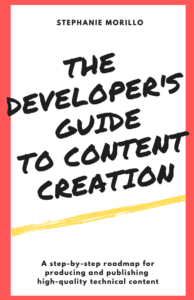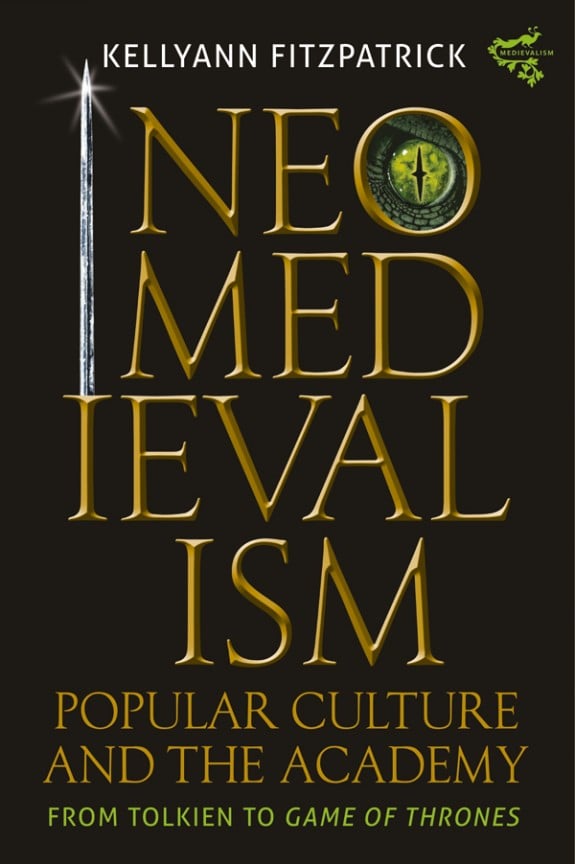 Stephanie Morillo, The Developer’s Guide to Content Creation (2020).
Stephanie Morillo, The Developer’s Guide to Content Creation (2020).
About this book
As her title suggests, Stephanie Morillo’s recent (and self-published) book guides software developers through the steps of technical content creation. Along with the title, the book itself is practical in the best way: each chapter builds on the last to 1) introduce topics and processes and then 2) direct readers to put what they have learned immediately into practice using supplemental worksheets. The worksheets ask readers to focus on their own specific goals and to mine their existing knowledge base; because of this, the entire process (as is the case with the best written guides) feels more like participating in an individualized workshop than reading a book.
It is important to note that this book focuses primarily on shorter, repeatable written content (such as blog posts; this is not a book about writing books) and supporting social media strategies. While Morillo covers how to create written content that supports collateral such as podcasts and videos–and, indeed, the organizational processes covered in some of the chapters could be easily translated to other media–the guidance around written content is where this book really shines.
Organization
Another strength of the book is its organizational strategy (the table of contents is available here) which, as Morillo notes, is intended to “mirror the writing process” from brainstorming to revising to promoting. Distributed throughout the book (and also consolidated at the end) is a useful list of external resources and suggested further reading related to each stage of this process along with the corresponding exercises and worksheets. While some readers might want more emphasis on the drafting and revision processes per se, the sections on brainstorming and outlining are on point, as is the emphasis on understanding the mission/purpose and intended audience of any content creation effort.
Morillo is also directive about reading the book from start to finish (a prescription with which I agree), and this attention to telling readers how to use the book is itself a sign that Morillo is really good at writing instructional content.
Audience(s)
This book also does very well in translating content creation terminology, tools, and processes into developer-friendly terms (and it includes a definition of “content”). Morillo has an excellent overview of marketing terms (including her own hand-drawn diagram of a marketing funnel), and while some developers may be familiar with such terms, this is a useful primer for those who are not. There is also a taxonomy of the different tools and platforms available for hosting a blog (from CMS to static site generators to fully-hosted options), as well as some insight into how a developer might choose to piece together their online profile by placing materials in a strategic variety of venues (such as GitHub, dev.to, Twitch).
Although the stated audience is developers, for the most part the book is potentially useful to anyone looking to create technical content. For example, Morillo has a great section on how to format code blocks if your site does not support the appropriate formatting. Her solution? Consider adding a screen shot (for visibility) but also linking to a gist, which would allow for both appropriate formatting and compatibility with assistive screen readers (see p. 56; I love the emphasis on accessibility). While Morillo assumes her readers will know what a gist is (my informal inquiries indicate that the term can be unfamiliar to devs and non-devs alike), a quick switch to a search engine can help fill in any knowledge gaps and confirm that this is, in fact, a useful option for code blocks.
Final thoughts
Morillo’s book is a relatively short (for a book) and congenial read. For folks who have never authored this type of content before, Morillo’s breakdown of the content creation process into actionable pieces will be a revelation. Even for folks who write all the time (hello, fellow tech writers and analysts), Morillo’s specific breakdown of planning and execution are worth a look, and her insight into promoting content is super sharp (as evidenced by the meta-example of promotion for the book; extra kudos to Morillo for crowd-funding a giveaway of copies to developers from underrepresented groups ).
Above all, Morillo’s tone throughout is upbeat and consistently encouraging without reducing the complexity and difficulties of writing. As she notes, “The truth about the writing process is that writing is hard” (p. 47); this is an excellent book to have at hand for anyone brave enough to go through that process.
How to get this book
You can purchase a copy (or a bundle of 10 copies at a reduced team rate) at https://www.developersguidetocontent.com/
Each purchase gets you access to a PDF version of the book (at present you also get access to ePUB and mobi versions, although there seems to be some technical issues with these formats). Worksheets are available as linked PDFs and spreadsheets.
Disclosure: GitHub and Amazon (Twitch) are RedMonk clients.

No Comments